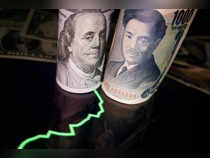 Reuters
ReutersIn the broader market, the dollar was on the front foot and stood near an eight-week high against a basket of currencies, helped in part by a weaker yen and as it rose in step with U.S. Treasury yields.
The yen edged a marginal 0.1% higher to 160.63 per dollar in the early Asian session, though remained just a fraction away from Wednesday's low of 160.88, its weakest level since 1986.
The Japanese currency has fallen some 2% for the month and 12% for the year against a resilient greenback, as it continues to be hammered by stark interest rate differentials between the U.S. and Japan, which has maintained the appeal of using the yen as a funding currency for carry trades.
In a carry trade, an investor borrows in a currency with low interest rates and invests the proceeds in higher-yielding assets.
Still, the yen's latest slide past the key 160 per dollar level has kept traders nervous over possible intervention from Tokyo, after authorities spent 9.79 trillion yen ($60.94 billion) at the end of April and in early May to push the yen up 5% from its 34-year low of 160.245 then.
Analysts said while the risk of intervention has increased, Japanese authorities could be holding out for Friday's release of the U.S. personal consumption expenditures (PCE) price index before entering the market.
"Both the level of the exchange rate and pace of the depreciation are important for the Ministry of Finance (MoF) to consider intervening in FX markets," said Boris Kovacevic, global macro strategist at Convera.
"However, subdued volatility in options markets suggests that the recent leg higher has not met all criteria the MoF is looking for.
"Policymakers could wait out Friday's PCE report that is expected to show continued disinflation in the U.S. before making a final decision before the weekend."
DOLLAR STRENGTH
Sterling struggled to break away from an over one-month low of $1.2616 hit the previous session and last bought $1.2622, succumbing to a stronger dollar.
The euro, which on Wednesday similarly fell to its weakest level since the beginning of May, was last 0.01% higher at $1.0680.
The common currency was on track to lose roughly 1.5% for the month, weighed down by political turmoil in the euro zone in the lead up to France's snap election set to begin this weekend.
The dollar index meanwhile hovered near a roughly two-month high and steadied at 106.05, drawing support from elevated U.S. Treasury yields. [US/]
The benchmark 10-year yield rose two basis points to 4.3392% on Thursday, while the two-year yield last stood at 4.7576%.
"I just think it's a combination of things," said Ray Attrill, head of FX strategy at National Australia Bank, of the higher U.S. yields.
"A few people have been mentioning when (Japan) intervened back in April, May, that there was some suggestion that if the Bank of Japan was going to have to be offloading Treasuries to fund the intervention, it could have an impact.
"But I think there's maybe a bit of a... lag effect of - Aussie yields were much higher after the CPI, and I think for once, that actually had a little bit of contagion impact to bond markets elsewhere."
An upside surprise in Australian inflation on Wednesday had caught traders off-guard and prompted markets to raise the chances of another interest rate hike this year, which in turn sent domestic yields higher.
That gave the Australian dollar a slight boost in the previous session, though it was short lived as the Antipodean currency failed to sustain its gains against a stronger dollar.
The Aussie was last 0.02% lower at $0.6646, while the New Zealand dollar fell 0.07% to $0.6079.
($1 = 160.6500 yen)
(What's moving Sensex and Nifty Track latest market news, stock tips, Budget 2024 and expert advice, on ETMarkets. Also, ETMarkets.com is now on Telegram. For fastest news alerts on financial markets, investment strategies and stocks alerts, subscribe to our Telegram feeds .)
Subscribe to The Economic Times Prime and read the Economic Times ePaper Online.and Sensex Today.
Top Trending Stocks: SBI Share Price, Axis Bank Share Price, HDFC Bank Share Price, Infosys Share Price, Wipro Share Price, NTPC Share Price
Read More News on
(What's moving Sensex and Nifty Track latest market news, stock tips, Budget 2024 and expert advice, on ETMarkets. Also, ETMarkets.com is now on Telegram. For fastest news alerts on financial markets, investment strategies and stocks alerts, subscribe to our Telegram feeds .)
Subscribe to The Economic Times Prime and read the Economic Times ePaper Online.and Sensex Today.
Top Trending Stocks: SBI Share Price, Axis Bank Share Price, HDFC Bank Share Price, Infosys Share Price, Wipro Share Price, NTPC Share Price












 Get Unlimited Access to The Economic Times
Get Unlimited Access to The Economic Times
